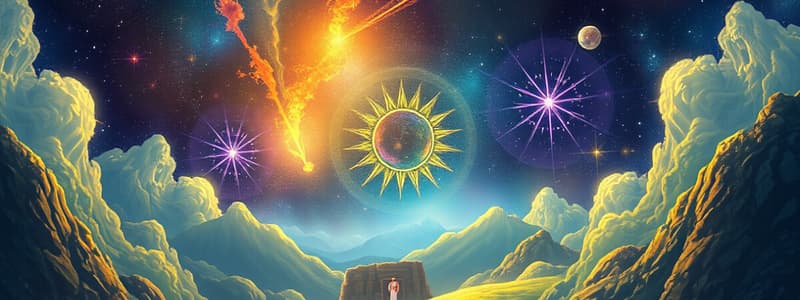Podcast
Questions and Answers
What does the term 'siddhānta' refer to in the context of the Vedāṅga Jyotiṣa?
What does the term 'siddhānta' refer to in the context of the Vedāṅga Jyotiṣa?
- The study of celestial navigation
- Methodology in astronomy
- Fundamental principles of physics
- A collection of conclusions or treatises (correct)
Which system did early Greek and Indian astronomers primarily use for their calculations?
Which system did early Greek and Indian astronomers primarily use for their calculations?
- Elliptical orbit system
- Flat Earth model
- Heliocentric system
- Geocentric system (correct)
What is the purpose of the intercalary lunar month (adhikamāsa) in traditional calendars?
What is the purpose of the intercalary lunar month (adhikamāsa) in traditional calendars?
- To represent festivals in the lunar calendar
- To adjust astrological predictions
- To increase the lunar year length to 365.24 days
- To align the lunar year with the solar calendar (correct)
What phenomenon could early astronomers not explain due to their geocentric view?
What phenomenon could early astronomers not explain due to their geocentric view?
Which calculation technique was notably used in the Vedāṅga Jyotiṣa for planetary positions?
Which calculation technique was notably used in the Vedāṅga Jyotiṣa for planetary positions?
How does the solar year compare to the lunar year in traditional Indian calendars?
How does the solar year compare to the lunar year in traditional Indian calendars?
What did the term 'epicycles' refer to in early astronomical models?
What did the term 'epicycles' refer to in early astronomical models?
Who was Āryabhaṭa I, and what is his significance?
Who was Āryabhaṭa I, and what is his significance?
What does jyotiṣa initially combine according to the Vedāṅga Jyotiṣa?
What does jyotiṣa initially combine according to the Vedāṅga Jyotiṣa?
Which civilization is noted for its high degree of town planning around 2600-1900 BCE?
Which civilization is noted for its high degree of town planning around 2600-1900 BCE?
What element of the Vedāṅga Jyotiṣa emphasizes the importance of jyotiṣa?
What element of the Vedāṅga Jyotiṣa emphasizes the importance of jyotiṣa?
What is the primary focus of the Vedāṅga Jyotiṣa?
What is the primary focus of the Vedāṅga Jyotiṣa?
Which of the following features were common in the town planning of Indus Valley cities?
Which of the following features were common in the town planning of Indus Valley cities?
What later meaning did jyotiṣa take on beyond astronomy and mathematics?
What later meaning did jyotiṣa take on beyond astronomy and mathematics?
In which geographical area was Dholavira located?
In which geographical area was Dholavira located?
What aspect of astrological influence is linked to jyotiṣa in the later context?
What aspect of astrological influence is linked to jyotiṣa in the later context?
What is the significance of the Yajur-Veda in the context of lunar mansions?
What is the significance of the Yajur-Veda in the context of lunar mansions?
Which text is recognized as the representative of advanced calendrical astronomy in late Vedic period?
Which text is recognized as the representative of advanced calendrical astronomy in late Vedic period?
What was the primary astronomical measurement identified in the Vedāṅga Jyotiṣa?
What was the primary astronomical measurement identified in the Vedāṅga Jyotiṣa?
What historical period is referred to as the Siddhāntic era?
What historical period is referred to as the Siddhāntic era?
How was the length of the sidereal day approximated in Vedic times?
How was the length of the sidereal day approximated in Vedic times?
What did the introduction of the seven-day week indicate about Bengali influences?
What did the introduction of the seven-day week indicate about Bengali influences?
What was the primary division of the month in late Vedic India?
What was the primary division of the month in late Vedic India?
What does the length of the sidereal day used in the Vedāṅga Jyotiṣa reflect?
What does the length of the sidereal day used in the Vedāṅga Jyotiṣa reflect?
Flashcards are hidden until you start studying
Study Notes
Vedāṅga Jyotiṣa and Indian Astronomy
- Discusses solstices (ayanānta) and equinoxes (viṣuva), establishing foundational concepts for astronomy.
- Utilizes two intercalary lunar months (adhikamāsa) to align the lunar calendar with the solar year.
- Addresses the discrepancy between the solar year (approximately 365.24 days) and lunar year (up to 360 days), necessitating the addition of intercalary months.
- Employs trigonometric methods and epicyclic models for calculating planetary positions.
- Reflects a geocentric worldview, leading to assumptions about planetary retrograde motion as smaller orbits circling larger paths.
Āryabhaṭa and Astronomical Texts
- Āryabhaṭa I, born in 476 CE, was a significant figure in the early development of Indian astronomy.
- The Vedāṅga Jyotiṣa, originating around 1400 BCE, signifies the earliest surviving Indian astronomical text.
- Describes astrology and mathematics as vital components of Vedāṅga śāstras, with "jyotiṣa" initially encompassing both fields.
- Highlights the cultural importance of astronomical knowledge for ritualistic practices during the late Vedic period.
Urban Planning and Calendrical Developments
- The Indus or Harappan civilization (2600-1900 BCE) demonstrated advanced town planning, featuring fortifications and aligned streets.
- The Yajur-Veda introduced the first list of 27 nakṣatras (lunar mansions), contributing to the understanding of celestial navigation.
- Illustrates influences from Babylonian and Greek traditions, particularly in adopting the seven-day week and the zodiac system (first noted in Yavanajātaka, c. 269 CE).
The Siddhāntic Era
- Marks the beginning of significant advancements in Indian mathematics and astronomy around the 5th century CE.
- The Siddhāntic texts are characterized as systematic, scientific presentations of astronomical knowledge, filling historical gaps post-Vedāṅga Jyotiṣa.
- Early measures of the sidereal day reflect remarkable precision: 23 h 56 min 4.6 s recorded compared to the accurate 23 h 56 min 4.091 s.
Studying That Suits You
Use AI to generate personalized quizzes and flashcards to suit your learning preferences.




